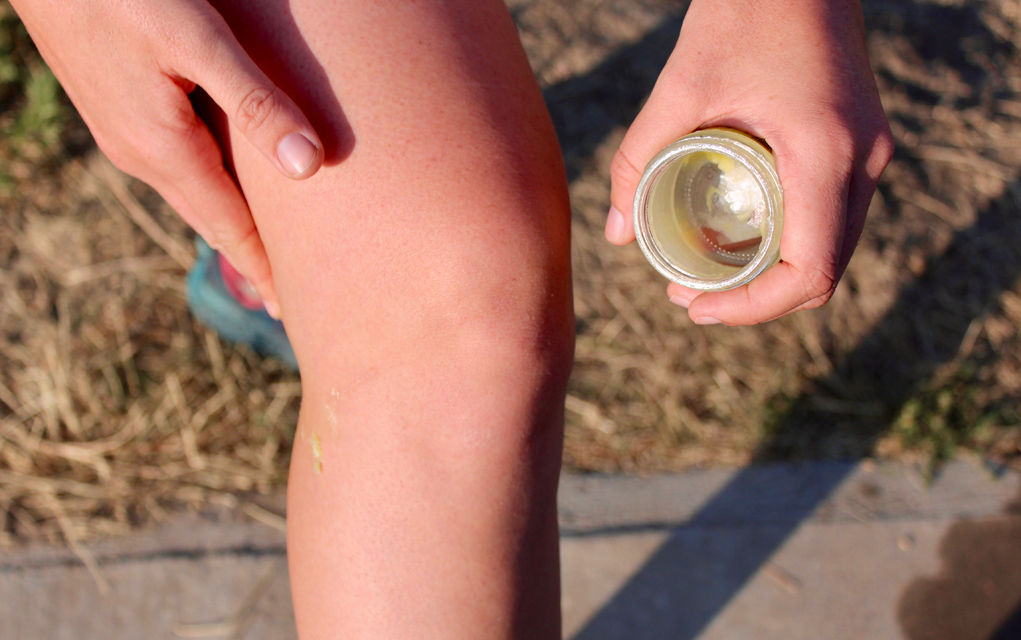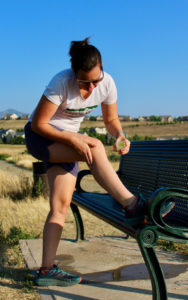
From the front window of Runners High in Golden, Colorado, shoppers can see Lookout Mountain and the iconic “M” on Mount Zion. The tiny specialty retail shop is a five-minute run from the trailhead for lungbuster Nightbird Gulch. But the views and the access aren’t the only things bringing customers into the shop these days — they’re stopping by to pick up topical cannabidiol, or CBD.
“We’re selling out of it constantly,” says co-owner Deb Spence. “We were buying 10 jars at a time, but it never lasted. Now we’re going through a case of 24 jars every two weeks or so. And we’re not a big store,” she adds.
Longtime athlete and Runners High customer Kristie McNamara discovered CBD when she was sidelined for a back injury. She also happened to have a degree in organic chemistry and had started her own line of natural skincare products, Tilvee Superfood Skincare. Armed with her chemistry knowledge, McNamara started looking for solutions for her debilitating back pain.
“I searched high and low,” she says, “I was desperate.” Four years later, the solution McNamara produced — Tilvee’s Hemp Sports Balm — is by far her best-selling product; it’s available online and at Runners High, and it’s part of a nationwide trend: Forbes reports that CBD sales are projected to reach the $3-billion threshold by 2021, and the supplement is getting attention among athletes, too.
Despite my initial reluctance, I’m one of those athletes. I’ve struggled with tightness in my IT band for years, and when nerve damage I sustained in a nasty tumble last fall derailed my 50K race training, I was ready to try anything. Amid recommendations for chiropractors, acupuncturists and physical therapists, one suggestion kept popping up: CBD.
Frankly, I was hesitant to try CBD. As a freelance writer, I probably won’t have to take a drug test anytime soon, but I couldn’t imagine trying to work (or run!) while stoned. The more I heard people rave about it, though, the more interested I became.

Let’s address the elephant in the room first: like marijuana, CBD is part of the cannabis family. It’s one of dozens of cannabis compounds, and it’s usually extracted from hemp — a fibrous marijuana relative that’s cultivated and used differently than its high-inducing cousin — or from the resin glands of the plant’s buds or flowers.
In topical form, CBD oil compounds are often used as an anti-inflammatory agent. A recent study by HelloMD and the Brightfield Group found that 54 percent of the 2,400 users surveyed use CBD products to treat joint pain and inflammation.
Based on that information (plus plenty of anecdotal experience from friends and fellow runners), I was fairly certain topical CBD would help reduce the inflammation I was experiencing in my right IT band. Still, I needed a little convincing that I wouldn’t get an unintended high.
“That’s the first questions my clients usually ask,” laughs Jacob Corley, a therapeutic massage practitioner at Boulder-based Optimal Function and Wellness, who regularly uses CBD products in his practice. “The short answer is: nope, you can’t get high on this stuff.”

McNamara — a mother who describes herself as “not a prude, but not ‘pro-pot’” — agrees. The longer answer, she explains to me, is that CBD binds to our bodies’ receptor sites differently than tetrahydrocannabinoil (THC), the cannabis plant’s best-known derivative (it’s the psychoactive element). It’s like trying to fit a square peg in a round hole: by its nature, CBD simply interacts with different receptors in the human body than THC does; hence, no high.
Corley says some of his patients are long-haul truck drivers whose livelihoods are contingent on their ability to pass regular drug screens. They’re understandably worried, but he says the trace amounts of THC — less than 0.3 percent — in CBD products isn’t enough to show up in a test, especially when it’s administered topically.
These answers had me nearly convinced, but I’m reticent to use anything that isn’t FDA-approved — especially when there’s as little formal research available as there is about topical CBD. Manufacturers and practitioners of sports medicine like McNamara and Corley are confident CBD products won’t result in failed drug tests, but there hasn’t been enough research to definitively guarantee that’s the case.
I needed to hear it from a medical professional, so I called Dr. George Sam Wang, who specializes in emergency medicine and medical toxicology at Children’s Hospital Colorado.
“There are a lot of hurdles,” he explains, adding that marijuana is a Schedule I substance, meaning that — although it’s legal for medical use in 29 states — it’s non grata, as far as the federal government is concerned.
“Despite state legalization [of medical marijuana],” he told me, “this makes research in this field difficult, due to federal and state disparities.”
This affects where you can legally purchase and use CBD, too. That 0.3-percent THC figure Corley mentioned to me is significant for CBD products: it’s the limit set forth by Section 7606 of the Agricultural Act of 2014. The “Farm Bill,” as it’s affectionately known, defines industrial-grade hemp as distinct from marijuana, and authorizes individual states to regulate its growth. Products derived from those legal plants, then — those that contain less than the 0.3-percent THC limit by volume — are federally legal. Still, it’s outlawed altogether in six states: West Virginia, Indiana, South Dakota, Kansas, Nebraska and Idaho.
If you happen to live in one of the other 44 states (and, to be sure, if you’re a Boulder County resident), you can legally possess CBD — and you won’t need to visit a dispensary to find it. CBD products are available not only at local retailers like Runners High, but also at a few well-known progressive grocery chains, like Lucky’s and Alfalfa’s. You can also purchase it online, directly from manufacturers or even via retail giants like Amazon. You’ll find pure hemp products at most health-food stores, but many don’t contain CBD — several of the experts I talked to advised me to look for the phrases “full spectrum” and “phytocannabinoid” to indicate that a product contains CBD.

Armed with enough information to fuel my own small-scale CBD research, I was ready to make the plunge. I picked up a jar of Tilvee’s Hemp Sports Balm at Runners High. It retails for $44.95, so I had high hopes it would be more effective than the NSAIDs I’d been popping.
I can’t speak for anyone else’s experience, but rubbing a generous helping of topical CBD on my tight spots — which, in my case, was my entire right IT band, from glute to ankle — had a pretty immediate effect. I felt those muscles relax for the first time in months. Combined with regular use of a foam roller, diligent stretching, and occasional visits to a chiropractor and acupuncturist, I credit this stuff with helping me finish my first 50k, which I did this May, mostly pain-free.
As I’d come to realize, I’m not alone in turning to CBD (or in finding that it works). “We’re seeing a lot more distance runners — who in the past would have reached for ibuprofen — now using full-spectrum hemp products,” says Ret Taylor, CEO of Ned & Co., which manufactures natural supplements including hemp derivatives, and who is an ultrarunner himself. “This is happening both during races and long training runs and afterward, for recovery and maintenance.”
Still, Wang reminded me that CBD is similar to other non-FDA-approved supplements. “People take various supplements for a lot of different things,” he explains. “A lot of those aren’t FDA-approved for content, efficacy or safety, so whether they help or not, you’re doing it at your own risk.”
McNamara also points out that individuals react differently to CBD, and that it should be part of a complete training and pain management program. That’s Corley’s outlook, too — his clients range from 20-somethings to a client in his mid-80s, and most are comfortable with his using topical CBD during their sessions.
“He always tells me,” says Corley of his 85-year-old client, “‘If I have 20 years left on this planet, I want to make sure I can move.’”
I couldn’t agree more.














